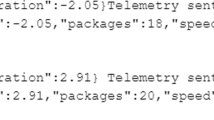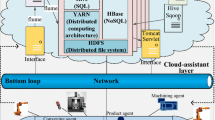Abstract
Based on the core developmental demands of smart steel manufacturing plants, this review analyzes the essential characteristics of the steel manufacturing process and its implications for production and operation decision optimization (PODO). A discussion on the potential application of technologies, including the Industrial Internet, big data, cloud computing, and 5G, in the PODO of smart steel plants based on the Industry 4.0 intelligent manufacturing and human-cyber-physical system (HCPS) is also presented. An adaptive update conception for a new dual-level cyber system (for management control and unit operation) of a flat-structured HCPS for steel plants is proposed to eliminate issues such as the hierarchical structure of the cyber system, the occurrence of data islands, and weak intelligence in PODO ability. Additionally, the review provided an in-depth analysis of the closed-loop decision logic of a dual-level HCPS. The critical technologies required for developing the HCPS model include data platforms and their associated application technologies, intelligent modeling, human-machine collaboration, and platform-based integration. Finally, suggestions are proposed to develop smart steel plants, including concept renewal, technological integration, and talent training.
Similar content being viewed by others
References
Industrie 4.0 Working Group, Federal Ministry of Education and Research. Recommendations for implementing the strategic initiative INDUSTRIE 4.0 (in Chinese). Mech Eng Trends, 2013, 7: 23–33
Keith B B, David B A, John D G, et al. Who will set the rules for smart factories? Issues Sci Technol, 2019, 35: 70–76
Offord A. Building a Britain Fit for the Future. Works Management, 2018, 1: 28–30
Sun Y H. New Industrial Revolution and EU New Industrial Strategy (in Chinese). Beijing: Social Science Academic Press, 2019. 151–153
Wang L Y, Li X X. Japan’s policy of intelligent manufacturing industry and its implication (in Chinese). J Northeast Asia Stud, 2019, 6: 100–110
Li H N, Chen Y T, Song W. National AI strategy of South Korea (in Chinese). Glob Sci Technol Ecol Outlook, 2020, 35: 21–26
Sun Y N, Bai X J. “Made in China 2025”—A strategy to strengthen China with Chinese characteristics (in Chinese). J Intell Manuf, 2020, 10: 43–45
Ding J L, Yang C E, Chen Y D, et al. Research progress and prospects of intelligent optimization decision making in complex industrial process (in Chinese). Acta Autom Sin, 2018, 44: 1931–1943
Yin R Y. Process engineering and manufacturing process (in Chinese). Iron Steel, 2014, 49: 15–22
Zhu J, Hu M J, Sun J J. Research on integrated mobile service platform of iron and steel enterprises (in Chinese). In: The Chinese Society for Metals. 2016 Internet+ and Steel Industry Intelligent Manufacturing Summit Proceedings. Tangshan, 2016. 37–39
Zhou J, Zhou Y, Wang B, et al. Human-Cyber-Physical Systems (HCPSs) in the context of new-generation intelligent manufacturing. Engineering, 2019, 5: 624–636
Yin R Y. Metallurgical Process Engineering (in Chinese). Beijing: Metallurgical Industry Press, 2009. 21–26
Yin R Y. A discussion on “smart” steel plant—View from physical system side (in Chinese). Iron Steel, 2017, 52: 1–12
Sun Y G. The development roadmap of digital, networked, and intelligent manufacturing technologies for the iron and steel industry (in Chinese). China Steel Focus, 2015, 9: 4–8
Wang C M, Zhou D D, Zu K, et al. Review of intelligent manufacturing technology in steel industry (in Chinese). China Metall, 2018, 28: 1–7
Sun Y G. Integrated optimization of intelligent manufacturing in iron and steel industry (in Chinese). Sci Technol Rev, 2018, 36: 30–37
Yin R Y. The essence, function, and future development mode of steel plant (in Chinese). Sci Sin Tech, 2008, 38: 1365–1377
Zeng J Q. Thoughts on intellectualization improvement of iron and steel production process (in Chinese). Metall Ind Autom, 2019, 43: 13–19
Zheng Z, Long J Y, Gao X Q, et al. Present situation and prospect of production control technology focusing on planning and scheduling in iron and steel enterprise (in Chinese). Comput Integr Manuf Syst, 2014, 20: 2660–2674
Schirner G, Erdogmus D, Chowdhury K, et al. The future of human-in-the-loop cyber-physical systems. Computer, 2013, 46: 36–45
Krugh M, Mears L. A complementary cyber-human systems framework for Industry 4.0 cyber-physical systems. Manuf Lett, 2018, 15: 89–92
Nunes D, Silva J S, Boavida F. A Practical Introduction to Human-in-the-Loop Cyber-Physical Systems. Hoboken: John Wiley & Sons, 2018. 21–24
Sowe S K, Zettsu K, Simmon E, et al. Cyber-physical-human systems: Putting people in the loop. IT Prof, 2016, 18: 10–13
Fonseca F, Marcinkowski M, Davis C. Cyber-human systems of thought and understanding. J Assoc Inf Sci Tech, 2018, asi.24132
Yin R Y. The energy flow behaviors and energy flow network problems in steel manufacturing process (in Chinese). J Eng Stud, 2010, 2: 1–4
Yin R Y. Structural analysis on steel manufacturing process and some problems of engineering effectiveness (in Chinese). Iron Steel, 2000, 35: 1–7
Tang L, Liu G. A mathematical programming model and solution for scheduling production orders in Shanghai Baoshan Iron and Steel Complex. Eur J Operat Res, 2007, 182: 1453–1468
Pacciarelli D, Pranzo M. Production scheduling in a steelmaking-continuous casting plant. Comput Chem Eng, 2004, 28: 2823–2835
Tang L, Liu J, Rong A, et al. A multiple traveling salesman problem model for hot rolling scheduling in Shanghai Baoshan Iron & Steel Complex. Eur J Operat Res, 2000, 124: 267–282
Cowling P I, Ouelhadj D, Petrovic S. A multi-agent architecture for dynamic scheduling of steel hot rolling. J Intell Manuf, 2003, 14: 457–470
Yan W L, Jiang C H, Chen Z P, et al. Narrow window control of BOF steelmaking end point based on two-mode switching (in Chinese). In: The China Automation Congress 2019, Chinese Assoc Autom. Hangzhou, 2019. 43–50
Chen C, Wang N, Yu H Y, et al. Evaluation model of converter operation process based on chi-square boxing method and logistic regression algorithm (in Chinese). J Mater Metall, 2019, 18: 87–91
Chen K, Zheng Z, Zhou C. Simulation method for multi-machine and multi-task crane scheduling in steelmaking plant (in Chinese). J Chongqing Univ, 2011, 34: 39–45
Zhang K, Liu J, Cui H, et al. Analysis of meniscus fluctuation in a continuous casting slab mold. Metall Mater Trans B, 2018, 49: 1174–1184
He C W. Study on iron making technology and application of blast furnace (in Chinese). Metall Mater, 2019, 39: 110–111
Deng X X, Pan H W, Ji C X, et al. Review on high speed conventional slab continuous casting of low carbon steel (in Chinese). Iron Steel, 2019, 54: 70–81
Jiang S L, Qian W P, Gao W W. A real-time and intelligent scheduling system applied in steelmaking shop towards wire and rod (in Chinese). In: The Chinese Society for Metals, ed. Proceedings of the 9th China Iron and Steel Annual Conference. Beijing, 2013. 3334–3339
PSI Metals. PSI metals brochure [OL]. PSI metals, 2017. 1–12, [2020-12-01]. https://www.psimetals.de/fileadmin/files/downloads/PSI_BT/1_Brochures/PSI_Metals_Image_Brochure.english.pdf
Peter N. AIS SteelPlanner—The production planning, scheduling and control solutions for the steel industry (in Chinese). In: China Iron and Steel Association, ed. International Symposium on Steel Industry Informatization. Dalian, 2005, 7: 52–57
Xie X P. Implementation and improvement of Broner production scheduling system at Tisco (in Chinese). Shanxi Metall, 2009, 32: 16–19
Zhou W, Wei Z. Steelmaking scheduling TPS solution in Baosight MES-APS (in Chinese). Inform Technol Standard, 2010, 9: 49–53
Liu Q, Qin J S. Perspectives on big data modeling of process industries (in Chinese). Acta Autom Sin, 2016, 42: 161–171
Liu M. A survey of data-based production scheduling methods (in Chinese). Acta Autom Sin, 2009, 6: 785–806
Ning C, You F. Data-driven stochastic robust optimization: General computational framework and algorithm leveraging machine learning for optimization under uncertainty in the big data era. Comput Chem Eng, 2018, 111: 115–133
Hashem I A T, Yaqoob I, Anuar N B, et al. The rise of “big data” on cloud computing: Review and open research issues. Inf Syst, 2015, 47: 98–115
Wang J N. Research on remote operation and maintenance technology based on cloud computing used in industrial scene (in Chinese). Process Autom Instrum, 2019, 40: 67–70
Yang C, Huang Q, Li Z, et al. Big Data and cloud computing: Innovation opportunities and challenges. Int J Digital Earth, 2017, 10: 13–53
Shen Z, An G, Yu M M. Exploration and application of 5G in industrial Internet (in Chinese). Inform Commun Technol, 2019, 13: 17–22
Volker S, Anne B, Vasco S, et al. Structural development and evaluation of profitable industrial use cases based on innovative technologies like 5G. Procedia CIRP, 2019, 81: 1119–1124
Wollschlaeger M, Sauter T, Jasperneite J. The future of industrial communication: Automation networks in the Era of the Internet of Things and Industry 4.0. IEEE Ind Electron Mag, 2017, 11: 17–27
Zhang H K, Cheng Y J, Yang D. State of the art of industrial network technologies: A review and outlook (in Chinese). Chin J Internet Things, 2017, 1: 13–20
Park J. Advances in future internet and the industrial internet of things. Symmetry, 2019, 11: 244–247
Zhang J. The industrial intelligence network has brought about new changes in industrial production (in Chinese). Wisdom China, 2020, 4: 48–49
Guo N, Jia C. Interpretation of “Cyber-Physical Systems Whitepaper (2017)” (Part One) (in Chinese). Inform Technol Standard, 2017, 4: 36–40
Author information
Authors and Affiliations
Corresponding author
Additional information
This work was supported by the Key Program of the National Natural Science Foundation of China (Grant No. 51734004), and the National Key R&D Program of China (Grant Nos. 2017YFB0304005, and 2020YFB1712800).
Rights and permissions
About this article
Cite this article
Zheng, Z., Zhang, K. & Gao, X. Human-cyber-physical system for production and operation decision optimization in smart steel plants. Sci. China Technol. Sci. 65, 247–260 (2022). https://doi.org/10.1007/s11431-020-1838-6
Received:
Accepted:
Published:
Issue Date:
DOI: https://doi.org/10.1007/s11431-020-1838-6




